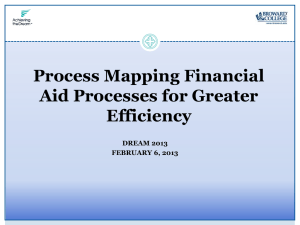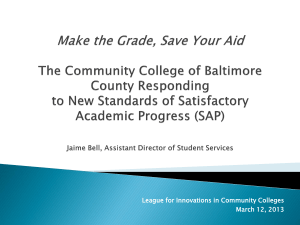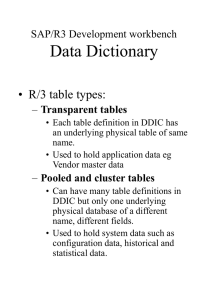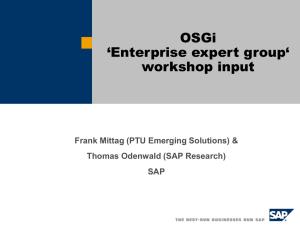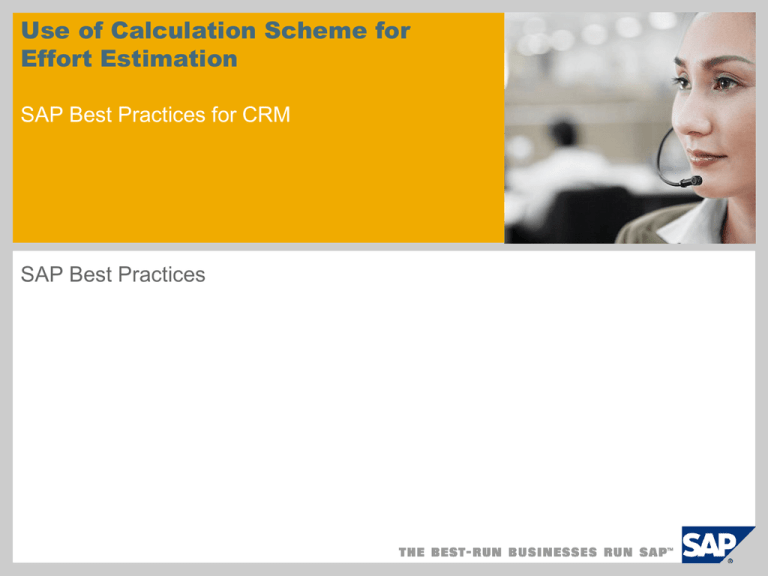
Use of Calculation Scheme for
Effort Estimation
SAP Best Practices for CRM
SAP Best Practices
Prerequisites and Assumption for Effort
Estimation
The following prerequisites and assumptions have to be taken into consideration before using the
calculation scheme for SAP Best Practices for CRM.
These figures are only rough orientation values and cannot be guaranteed.
Scope
Estimation is restricted to pure scenario configuration, which means that no other implementation
project activities are included
Automated configuration (Business Configuration Sets, eCATTs) is applied
Only functional scope of SAP Best Practices scenarios is covered
Initial setup of the prototype or development system; no production system
SAP ERP integration effort estimation is based on the following assumptions:
– Integration concept and scope has been defined in detail before replication
– Consistent ERP master data and customizing data for replication
– Limited amount of ERP data (sample data) that has to be replicated into the CRM system
– Only master data integration as defined for SAP Best Practices scope
System landscape
CRM system landscape has to be installed completely and error-free before starting the SAP Best
Practices installation; only connectivity is covered by Best Practices
Specific technical configuration topics, such as telephony integration (Interaction Center) are not
included
Skills
Knowledge of CRM, ERP and BI functionalities is required
Estimation is based on an experienced SAP Best Practices user; therefore the figures for the first
installation may be exceeded
Calculation Scheme Use
The SAP Best Practices for CRM configuration is divided into separate configuration units, socalled Building Blocks.
The installation effort for a Building Block in person days is listed in column Installation Effort per
Building Block in PDs.
The configuration of a scenario requires specific Building Blocks.
The row Effort for Single Scenario Installation contains the effort that is required to install only
this scenario, with no other scenario having been installed before.
The row Effort for Incremental Scenario Installation contains the effort for adding this scenario to
already installed scenarios.
In this case the effort is reduced because the same Building Block can be used by different
scenarios, that is, if a Building Block has already been installed for one scenario, there is no
need to install it again for a second scenario.
For installing the complete SAP Best Practices for CRM the effort for all Building Blocks has to
be summed up.
© 2010 SAP AG. All rights reserved.
No part of this publication may be reproduced or transmitted in any form or for any purpose without the express permission of SAP AG. The information contained herein may be changed
without prior notice.
Some software products marketed by SAP AG and its distributors contain proprietary software components of other software vendors.
Microsoft, Windows, Excel, Outlook, and PowerPoint are registered trademarks of Microsoft Corporation.
IBM, DB2, DB2 Universal Database, System i, System i5, System p, System p5, System x, System z, System z10, System z9, z10, z9, iSeries, pSeries, xSeries, zSeries, eServer, z/VM, z/OS,
i5/OS, S/390, OS/390, OS/400, AS/400, S/390 Parallel Enterprise Server, PowerVM, Power Architecture, POWER6+, POWER6, POWER5+, POWER5, POWER, OpenPower, PowerPC,
BatchPipes, BladeCenter, System Storage, GPFS, HACMP, RETAIN, DB2 Connect, RACF, Redbooks, OS/2, Parallel Sysplex, MVS/ESA, AIX, Intelligent Miner, WebSphere, Netfinity, Tivoli and
Informix are trademarks or registered trademarks of IBM Corporation.
Linux is the registered trademark of Linus Torvalds in the U.S. and other countries.
Adobe, the Adobe logo, Acrobat, PostScript, and Reader are either trademarks or registered trademarks of Adobe Systems Incorporated in the United States and/or other countries.
Oracle is a registered trademark of Oracle Corporation.
UNIX, X/Open, OSF/1, and Motif are registered trademarks of the Open Group.
Citrix, ICA, Program Neighborhood, MetaFrame, WinFrame, VideoFrame, and MultiWin are trademarks or registered trademarks of Citrix Systems, Inc.
HTML, XML, XHTML and W3C are trademarks or registered trademarks of W3C®, World Wide Web Consortium, Massachusetts Institute of Technology.
Java is a registered trademark of Sun Microsystems, Inc.
JavaScript is a registered trademark of Sun Microsystems, Inc., used under license for technology invented and implemented by Netscape.
SAP, R/3, SAP NetWeaver, Duet, PartnerEdge, ByDesign, Clear Enterprise, SAP BusinessObjects Explorer, and other SAP products and services mentioned herein as well as their respective
logos are trademarks or registered trademarks of SAP AG in Germany and other countries.
Business Objects and the Business Objects logo, BusinessObjects, Crystal Reports, Crystal Decisions, Web Intelligence, Xcelsius, and other Business Objects products and services mentioned
herein as well as their respective logos are trademarks or registered trademarks of SAP France in the United States and in other countries.
All other product and service names mentioned are the trademarks of their respective companies. Data contained in this document serves informational purposes only. National product
specifications may vary.
The information in this document is proprietary to SAP. No part of this document may be reproduced, copied, or transmitted in any form or for any purpose without the express prior written
permission of SAP AG.
This document is a preliminary version and not subject to your license agreement or any other agreement with SAP. This document contains only intended strategies, developments, and
functionalities of the SAP® product and is not intended to be binding upon SAP to any particular course of business, product strategy, and/or development. Please note that this document is
subject to change and may be changed by SAP at any time without notice.
SAP assumes no responsibility for errors or omissions in this document. SAP does not warrant the accuracy or completeness of the information, text, graphics, links, or other items contained
within this material. This document is provided without a warranty of any kind, either express or implied, including but not limited to the implied warranties of merchantability, fitness for a
particular purpose, or non-infringement.
SAP shall have no liability for damages of any kind including without limitation direct, special, indirect, or consequential damages that may result from the use of these materials. This limitation
shall not apply in cases of intent or gross negligence.
The statutory liability for personal injury and defective products is not affected. SAP has no control over the information that you may access through the use of hot links contained in these
materials and does not endorse your use of third-party Web pages nor provide any warranty whatsoever relating to third-party Web pages.





